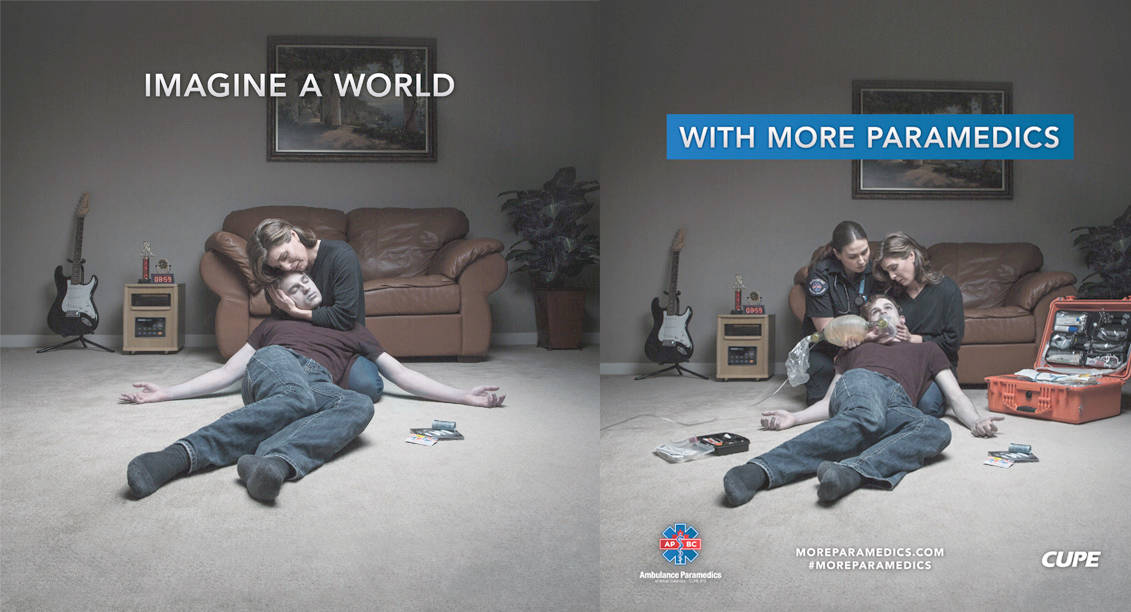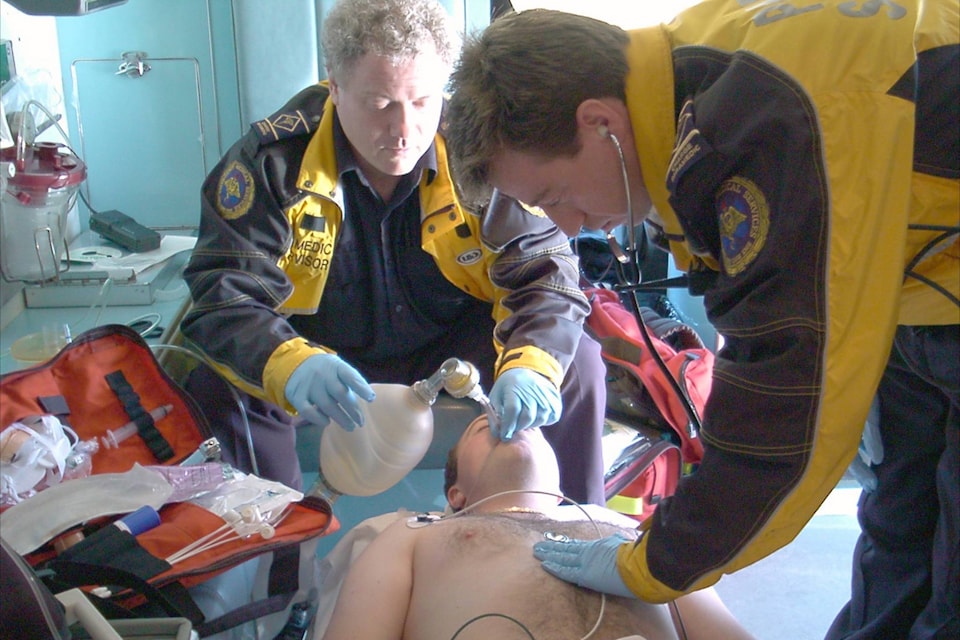Fourth in a series looking at serious issues with emergency health services in British Columbia.
If you have a story to share with us about your experiences, send an email to newsroom@castlegarnews.com.
One thing that has been consistent in all of the interviews that Castlegar News has done during the Critical Condition series has been that every person has been supportive of the work actual ambulance attendants and paramedics are doing, even from the people who have come to us with heartbreaking stories of things not turning out well for their loved ones.
The criticisms all run to the system and policies driving the ambulance service itself. The complaints have a common theme — slow response times, long delays because no ambulance is available locally, being transported by slow ground ambulances over long distances instead of by air, long waits for a transfer from a smaller hospital that can’t help them to a larger hospital and the absence of paramedics with advanced training that could have done more during that long journey to the hospital.
Castlegar News has spoken to numerous people across the country who are involved in the emergency health services field who have expressed frustrations and concerns about the state of pre-hospital care in British Columbia. We have agreed to withhold their names due to their fears of repercussions for speaking out.
One of the frustrations brought forward was that even though there are trained Advanced Care Paramedics (ACP) in rural communities they are not allowed to practice at that level because British Columbia Emergency Health Services (BCEHS) has only designated that level of care for larger population centres.
These paramedics would like to stay in their communities and help people with the skills and training they have, but BCEHS will not authorize them to do so, or provide Advanced Life Support (ALS) equipped ambulances to operate out of. BCEHS operates 28 ALS ambulances — all in major urban centres. Alberta, however, has about two-thirds of their fleet — about 250 — operating at that level, including many in small towns.
To be designated as Advanced Life Support the ambulance must be staffed by ACPs and have the speciality equipment on board needed to perform the tasks the ACPs are trained to do. This includes medications, cardiac monitors and tools for intubating patients.
ACPs perform all of the tasks that Primary Care Paramedics provide plus they can perform advanced airway management such as intubation, advanced resuscitation techniques such as cardiac defibrillation and pacing and administration of numerous medications including using nebulized, intravenous and subcutaneous routes, urinary catheterization and needle thoracentesis.
The paramedics explained that not everyone wants to live in the Vancouver area. There is a feeling that the organization is trying to keep the most trained paramedics and the best equipment for the big cities.
That sentiment is not just felt by paramedics, but by citizens and officials in communities all across rural B.C.
B.C. Health Minister Adrian Dix agreed with some of the criticism coming from rural areas in a recent interview, “When people say that the service has been inadequate in rural B.C. — I agree with that,” he said.
BCEHS paramedic numbers
Total paramedics — 4000+
Emergency Medical Responder (EMR) — 534
Primary Care Paramedics (PCP) — 2,864
Advanced Care Paramedic (ACP) — 338
Infant Transport Team (ITT) — 25
Critical Care Paramedic (CCP) — 54
Dispatch Paramedics — 290
Community Paramedics — 57
ACP residency program
There is another hurdle to becoming an ACP in B.C.: after completing training and receiving an Advanced Care Paramedic License from the Emergency Medical Licensing Board, BCEHS requires paramedics to complete its ACP Residency Program.
The program only takes place in Vancouver and takes six to 12 months to complete. If you are not living in that area and have been working as a paramedic elsewhere this can cause quite a hardship: leaving your job, relocating to a city where the cost of living is expensive, leaving a partner or children behind.
This model is unique to B.C and the program is run by the employer, BCEHS. All paramedics wishing to work as ACPs for BCEHS must participate in the program, no matter how much experience or training they may have, even if they have been working as an ACP elsewhere for years.
BCEHS executive vice president Linda Lupini says the organization is looking at the training program and its hurdles for those outside of major centres.
“I don’t have any quick answers to that but we are certainly cognizant that more and more people would like to do that and that it does become a little bit difficult,” she said.
“But if you want to be a good advanced care paramedic you are going to have wanted to see a lot and practice before you are on your own responding to a trauma you have never seen before,” she said explaining why the training only took place in a big city.
One practitioner who we talked to found that idea frustrating as those who have graduated as ACPs will have already practised extensively during their three years of training, and again coming back to the fact that ACPs successfully work in rural areas in other provinces.
Lupini added that if training were to take place in a smaller centre it would take longer. But that isn’t an option as there are no ACPs stationed in those smaller centres to provide the mentorship training.
So in the end, to practice as an ACP in B.C. you have to resolve to not only relocate for your training, but also relocate permanently to one of the handfuls of locations that have designated ACP positions.
BCEHS Paramedic Training Levels
Emergency Medical Responder (EMR) — Three weeks in class plus Occupational First Aid 3 prerequisite
Primary Care Paramedics (PCP) — Four months in class, 12 shift practicum
Advanced Care Paramedic (ACP) — PCP and two additional years in class, 20-week practicum
Infant Transport Team (ITT) — ACP plus 18 months training, six months mentorship
Critical Care Paramedic (CCP) — ACP plus 18 months training, six months mentorship
Transfers using up time and resources
Another source of frustration is the amount of time spent doing transfers between facilities including from care homes to hospitals for routine tests when an ambulance isn’t really needed, and the patients just need a ride. These transfers can easily take several hours.
Communities across the province, including Castlegar, have been asking BCEHS for more staff and more ambulances for quite some time. In Castlegar, for example, staff and car numbers remain the same as they were in the 1970s. At that time the community had a full-time hospital, now it only has a daytime-only health centre and there has been population growth since that time.
Some critics think that BCEHS should add dedicated transfer ambulances to their fleet, freeing up the remaining ambulances to respond to 911 calls.
Paramedics Union has concerns
When the NDP government passed the Health Emergency Act in 1974, the B.C. Ambulance Service was created and along with it the rule that only members of Ambulance Paramedics of British Columbia (APBC) CUPE Local 873 were to provide all pre-hospital care for the province.
On the Ambulance Paramedics of British Columbia-CUPE 873 website, the union mentions several issues it has with the current state of affairs at BCEHS and puts out a call for innovative solutions.
In March 2017, APBC launched a to educate residents about the need for more resources within their communities.
A press release for the campaign mentions that the national average response time goal for calls is eight minutes, 59 seconds. In British Columbia, this goal is only met 30 per cent of the time.
“Over the past 15 years, we’ve seen call volume increase. With that comes an increased demand for resources. The Government has not kept up with the demand for more resources and funding for our members. This means our frontline staff are now being stretched thin,” reads the release.
The campaign goes as far as saying: “The public is currently being put at risk because there are not enough ambulances to properly service residents of British Columbia.”
BCEHS expects demand to increase by 6.1 per cent annually.
The APBC website also mentions that larger communities are dealing with paramedic response time delays, emergency department overcrowding due to population increases and an increase in ambulance call volumes, partially due to residents who don’t need emergency medical care but find it difficult to access more appropriate health care services.
For smaller and rural communities the union talks about serious problems with paramedic recruitment and retention as low emergency call volumes make it difficult to justify the expense of full-time paramedic staffing.
In addition, they state, “The withdrawal of locally funded training has resulted in a steep decline in the number of paramedic applicants for rural communities and thus critical staffing shortages across the province, which leaves many communities facing long periods of time with reduced or no ambulance service.”
The union goes on to argue that with an aging population, “It is even more important that all British Columbians have an active and reliable ambulance service in their community.”
“Along with staffing shortages, the regionalization of more and more health care services means patients face longer and longer travel times to receive the care they need. The B.C. Ambulance Service must respond to these challenges by adapting to local needs and ensuring a reliable service to connect patients to the care they require.”
They also issued a call to action, “It is time that solutions to the ambulance and health-care issues faced by rural communities come to the forefront of British Columbia government discussions.
“We ask that you write both the Health Minister and Health Critic to express your concerns for the state of ambulance services and health care in your community.”
The awareness campaign’s website, , offers opportunities for action — you can check out a response time map, enter a response time for an ambulance call you have made and download a letter to send to your MLA.
Mental anguish
When it comes to those working the frontlines, the struggle to keep up with the pressure and the stress is taking a serious toll on paramedics.
Paramedics often carry a huge load for society. Not only are they there to physically take care of people during their most dire situations, they then carry the memories of those scenarios with them.
It is no wonder that paramedics struggle with occupational stress, post-traumatic stress disorder, and other mental health problems.
A recent University of Regina study found that among public safety professionals paramedics had the highest rate of suicidal thoughts, followed by operators and dispatchers.
Paramedics are never there for the good moments in life — they are there for the accidents, the heart attacks, the strokes, the brutality of crimes. They have to look into the eyes of the person whose loved one has died or is not likely to make it.
For those who are in the situation talked about earlier — having advanced training, but not being able to practice at that level because there are no advanced life support ambulances operating where you live — the mental strain is magnified.
The struggle with believing that if you had the right piece of equipment at your disposal an outcome might have been changed could be overwhelming. When mixed with an ethical and moral dilemma of being on a call where you felt that if you had the proper equipment, someone might have survived — the combination of stressors may just be too heavy of a load to carry.




